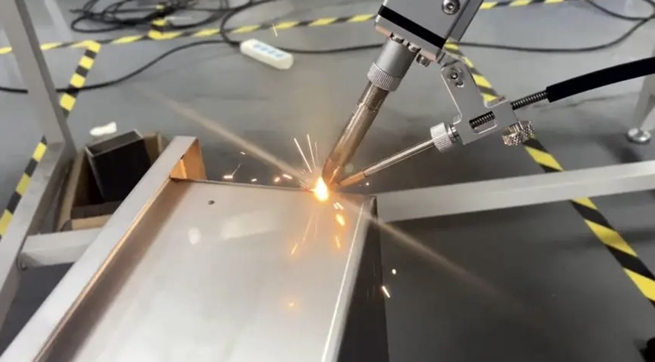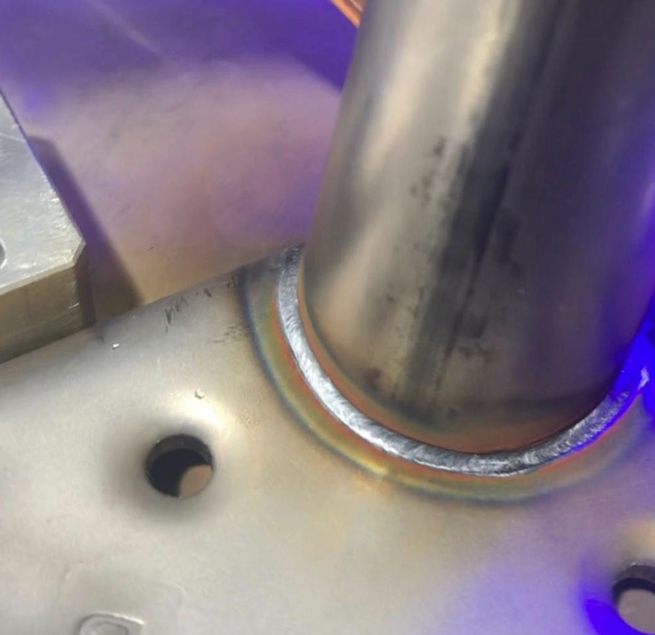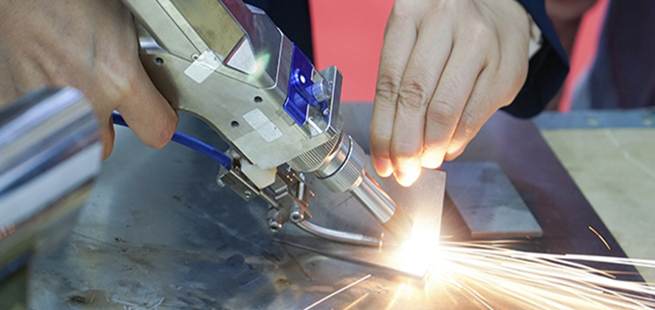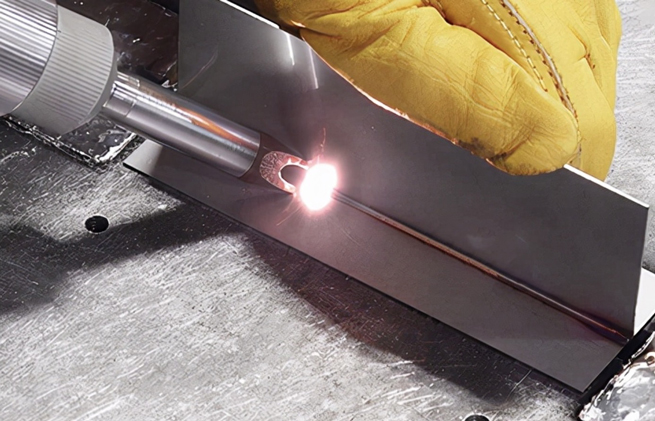Laser welding is an efficient and precise welding method that uses a high-energy density laser beam as a heat source.
Laser welding is one of the important aspects of the application of laser material processing technology.
Below is a brief introduction to several process methods.

1 Plate to plate welding
It includes four processing methods:
Butt welding;
End welding;
Center penetration welding;
Center perforation fusion welding.
2 Line to line welding
It includes four processing methods:
Line to line welding;
Cross welding;
Parallel lap welding;
T-shaped welding.
3 Welding of metal wires and block shaped components
Laser welding can successfully connect wires to lumped components, which can be of any size. When welding, attention should be paid to the geometric shape of the welding wire components.
4 Welding of different metals
The welding of different types of metals must address the range of weldability and weldability parameters.
Laser welding between different materials is only suitable for certain material combinations.
Laser brazing is not suitable for the connection of certain components, but laser can serve as a heat source for soft and hard brazing, which also has the advantages of laser brazing.
There are various ways to use brazing, among which laser soft brazing is mainly used for soldering printed circuit boards, especially suitable for chip component assembly technology.
Factors affecting the quality of laser welding
Laser welding is a process in which a high-energy laser beam irradiates a workpiece, causing a sharp increase in working temperature, resulting in the workpiece melting and re joining to form a permanent joint.
Laser welding has better shear strength and tear strength.
There are many factors that affect the quality of laser welding. Some of them are very unstable and have considerable instability. How to correctly set and control these parameters to maintain them within the correct range of high-speed continuous laser welding process, in order to ensure welding quality. The reliability and stability of weld formation are important issues related to the practicality and industrialization of laser welding technology.

The main factors affecting the quality of laser welding are welding equipment, workpiece condition, and process parameters.
1. Welding equipment
The most important quality requirements for lasers are beam mode, output power, and stability.
The lower the order of the beam pattern, the better the beam focusing performance, the smaller the spot, the higher the power density under the same laser power, and the greater the depth and width of the weld seam.
Generally, a base mode (TEM00) or low order mode is required, otherwise it is difficult to meet the requirements of high-quality laser welding.
At present, lasers in China are still difficult to be used for laser welding in terms of beam quality and power output stability.
From the perspective of foreign situations, the quality of laser beams and the stability of output power are already quite high and will not become a problem in laser welding.
The biggest factor affecting the welding quality of optical systems is the focusing lens, which generally uses a focal length between 127mm (5in) and 200mm (7.9in). A small focal length is beneficial for reducing the diameter of the focusing beam waist spot, but being too small can easily lead to contamination and splashing damage during the welding process.
The shorter the wavelength, the higher the absorption.
Usually, materials with good conductivity have higher reflectivity.
The reflectivity of YAG laser is 96% silver, 92% aluminum, 90% copper, and 60% iron.
The higher the temperature, the higher the absorbance, showing a linear relationship. Generally, surface coating with phosphate, carbon black, graphite, etc. can improve the absorption rate.

2. Workpiece condition
Laser welding requires high edge accuracy of the workpiece being processed and assembled, strict alignment between the welding points and the weld seam, and no distortion in the original assembly accuracy and point alignment of the workpiece due to welding heat during the welding process.
This is because the laser spot is small, the weld seam is narrow, and generally no filler metal is added. If the assembly gap is too large, the beam can pass through the gap and cannot melt the base material, or cause obvious light impact or depression. If the deviation between points is slightly large, it may lead to incomplete fusion or incomplete welding.
Therefore, the assembly gap and point seam deviation of the general board docking should not exceed 0.1mm, and the misalignment should not exceed 0.2mm.
In actual production, sometimes laser welding technology cannot be used due to the inability to meet these requirements.
To achieve good welding results, the allowable butt and lap gaps should be controlled within 10% of the thickness of the thin plate. Successful laser welding requires close contact between the substrates being welded. This requires careful tightening of the parts to achieve optimal results.
3. Welding parameters
(1) The most important welding parameter for the influence of laser welding method and weld formation stability is the power density of the laser spot. Its impact on the welding method and weld formation stability is as follows.
The laser spot power density, from small to large, is in the order of stable heat conduction welding, unstable mode welding, and stable deep penetration welding.
The power density of laser spot is mainly determined by the laser power and the position of the beam focus under a certain beam mode and focal length of the focusing mirror.
The laser power density is directly proportional to the laser power.
There exists an optimal value for the influence of focal position.
When the focus of the beam is at a certain position below the surface of the workpiece (within the range of 1-2mm, depending on the plate thickness and parameters), the most ideal weld seam can be obtained. Deviating from this optimal focus position will increase the surface light spot of the workpiece, leading to a decrease in power density. Within a certain range, it will cause changes in the form of the welding process.
The influence of welding speed on the welding process form and stable parts is not as significant as that of laser power and focus position. Only when the welding speed is too high, the stable deep penetration welding process cannot be maintained due to the small heat input.
During actual welding, stable deep penetration welding or stable heat conduction welding should be selected based on the requirements of the welding site for penetration depth, to absolutely avoid mode instability welding.
(2) The influence of welding parameters on penetration depth within the range of deep penetration welding.
Within a stable range of deep penetration welding, the higher the laser power, the greater the penetration depth, with a relationship of approximately 0.7 times.
Moreover, the higher the welding speed, the shallower the penetration depth.
Under certain laser power and welding speed conditions, the focus is at the optimal position when the penetration depth is maximum. If it deviates from this position, the penetration depth decreases and even becomes an unstable welding or stable heat conduction welding mode.
(3) The role of protective gases
The main functions of protective gases are:
Protect the workpiece from oxidation during the welding process.
Protect the focusing lens from metal vapor contamination and liquid droplet splashing.
Disperse the plasma generated by high-power laser welding.
Cool the workpiece and reduce the heat affected zone.
The protective gas is usually argon or helium, and if the apparent mass is not high, it is nitrogen.
Their tendency to produce plasma is significantly different: helium, due to its high ionization mass and fast thermal conductivity, has a lower tendency to produce plasma under the same conditions than argon, allowing for greater melting depth.
Within a certain range, as the flow rate of the protective gas increases, the trend of suppressing plasma increases, thereby increasing the depth of the melt, but it tends to become smooth within a certain range.
(4) Analysis of the monitorability of each parameter.
Among the four welding parameters, welding speed and shielding gas flow rate are easy to monitor and maintain stability, while laser power and focus position are parameters that may fluctuate during the welding process and are difficult to monitor.
Although the laser output power is highly stable and easy to monitor, the laser power reaching the workpiece will change due to the loss of the optical guide and focusing system, which is related to the quality, time use, and surface pollution of the optical workpiece, making it difficult to monitor and becoming an uncertain factor in welding quality.
The focus position of the beam is one of the most difficult factors to monitor and control in welding parameters that affect the quality of the weld seam.
At present, manual adjustment and repeated process testing are required in production to determine the appropriate focus position and obtain the required melt depth.
However, due to the deformation of the workpiece, thermal lens effect, or multi-dimensional spatial curve during the welding process, the focus position may change and may exceed the allowable range.
